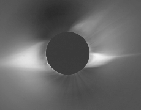Solar Eclipses

Do NOT look directly at the Sun when it's partially eclipsed!
DO look at the Sun when it is FULLY eclipsed!
1998 Eclipse News | The 1998 Eclipse Overview | Classroom Activities | More about Eclipses | Other Pages
A solar eclipse occurs when the Moon, during its monthly trip around the Earth, happens to line up exactly between the Earth and the Sun.
The glory of a solar eclipse comes from the dramatic view of the Sun's corona, or outer atmosphere, which we can see only when the brilliant solar disk is blocked by the Moon. The corona is not just light shining from around the disk. It is actually the outermost layer of the solar atmosphere. Although the gas is very sparse, it is extraordinarily hot (800,000 to 3,000,000 K), even hotter than the surface of the Sun! The corona shows up as pearly white streamers, and their shape is determined by the Sun's current magnetic fields. Thus every eclipse will be unique and beautiful in its own way.
News and Press Releases of the 26 February 1998 Solar Eclipse
- Stanford solar physicists take part in eclipse webcast
- SOHO spacecraft to assist eclipse observer
- SOHO Eclipse Page
- SwRI planetary scientists to observe February 26 total solar eclipse
- Science at the 1998 eclipse: heating of the solar corona
- Airmen in Panama support world's top eclipse research team
- Curacao Eclipse Tale (night observing & eclipse)
- Party eclipse lives up to nickname (MS NBC)
Images of the 26 February 1998 Solar Eclipse
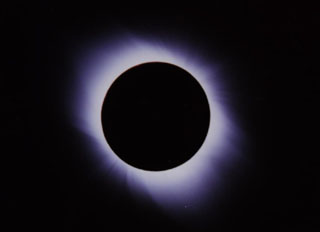
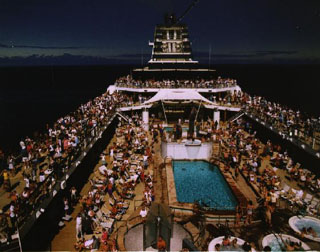
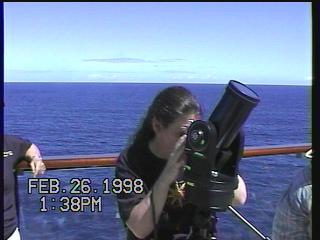
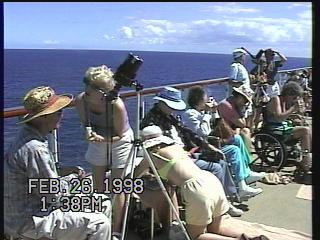
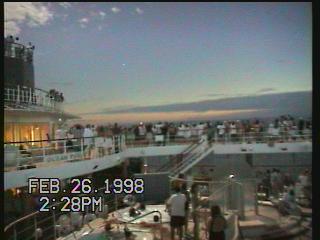
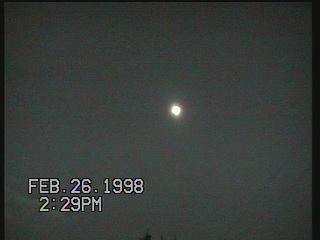
Other Web Images of the 26 February Eclipse
The Eclipse 98 Team broadcasted live images from multiple sites in the path of totality. A representative from the SOLAR Center providded images from a ship in the Caribbean!
The Exploratorium presented live online images and programs on the evening before as well as during the eclipse.
The Discovery Channel's "Chasing the Eclipse," A joint venture between the Exploratorium and the Discovery Channel.
Live!Eclipse 98 is a Japanese eclipse expedition that put live images on the Web during the eclipse.
Eclipse 98 are active members of the Seccion de Astronomia de Sociedad Venezolana de Ciencias Naturales in Venezuela promoting this eclipse and putting live images on the Web.
Bob Yen's Photography. Glorious eclipse photos! See also Yen's eclipse story.
First, try the best solar eclipse modeling activity around! Solar Eclipse Activities
Then, once your students have a general idea of how eclipses work, you can move on to a series of eclipse lessons available through Encarta(r) Online. The first 3 of these activities help students learn the concepts relating to eclipses.
In the last 2 lessons, students in the regions of the eclipse (the Galapagos Islands, Panama, Columbia, Venezuela, and the Caribbean) make observations, share their data with students in other parts of the world, and collaborate with them to formulate scientific predictions.
Latitude, Longitude, and Universal Time
Serves as an introduction to the concepts of latitude, longitude, and Universal Time.Gives some background about eclipses and introduces students to the concepts of partial and total solar eclipses, phase, path of totality, umbra, and penumbra. It includes an amateur video of the 1995 total solar eclipse observed in India.
Measuring the Sun with a Simple Sun Projector
Students make a "sun projector" using a small hand mirror, a paper screen, and a darkened room. This gives them a completely safe way to observe and make measurements of the sun. The sun projector can be used to estimate the diameter of the sun (in miles and kilometers) as well as track progress of a solar eclipse.
Observing the Solar Eclipse of 1998
Students who live in the path of the eclipse (partial or total) are invited to make observations of the eclipse, to share their data with students in other parts of the world and to collaborate with them to formulate scientific predictions.Using data submitted from observers stationed in various locations in North, Central and South America, students predict the path of totality and compare their results with observations made along the path.
Another lesson plan for learning about solar eclipses.
This step-by-step lesson plan provides an outline for the teacher, or parent, to guide the student through the the events of a total solar eclipse.About Solar Eclipses
When there is a solar eclipse, it is only visible from a small area of the Earth. It's unlikely that, during your lifetime, you will ever have a total solar eclipse right where you live. However, many people travel long ways to experience a total solar eclipse. Or, if you're lucky, you might be able to see a partial solar eclipse (one where the Moon doesn't quite cover all the Sun's disk) nearby someday.
You can safely observe a TOTALLY eclipsed Sun with your eyes. However, for observing the beginning and ending of an eclipse, or for a partial eclipse, you will need a pinhole camera, an appropriate type of welder's glass, or special Mylar glasses to observe the Sun safely.
1998 Solar Eclipse Page (NASA/GSFC)
NASA 1998 Solar Eclipse
SKY Online's Eclipse Page
Mirror sites for the Eclipse98 Team
Solar Eclipses (complete with animations)
Solar Data Anaylsis Center Eclipse Information
Eclipse Paths
Predictions of Some Total Solar Eclipses Compared with the Real Thing
The 1999 Total Solar Eclipse
If an eclipse occurs when the Moon lines up between the Earth and the Sun, shouldn't there be an eclipse every month? Solar eclipses do occur at New Moon, but not at every New Moon. Most often the Moon passes a little higher or a little lower than the Sun. There is a solar eclipse once or twice a year, when the Moon's and Sun's positions exactly line up.

This page is http://solar-center.stanford.edu/eclipse/eclipse.html
Copyright © 1998 Stanford University. All rights reserved.
Created by Deborah Scherrer
Last Modified by DKS or ALG on 5 March 1998.
